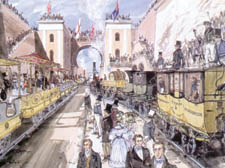|
|
 |
| |

The Liverpool & Manchester line became the first rail link between two major towns in 1830 |
Inside track on a bloody story of rail
Christian Wolmar’s new book charts the history of the first railways and looks to the future of train travel, writes Peter Gruner
Blood, Iron & Gold (How the railways transformed the world)
by Christian Wolmar. Atlantic books, £25.
?THOUSANDS died building them and worked in appalling conditions. The railways brought war and civilisation in equal measure and transformed the world.
In Blood, Iron & Gold, Christian Wolmar describes the vision and determination of the pioneers as well as the desperate lives of the navvies who were treated no better than slaves.
Wolmar, who lives in Holloway, takes up the story from his previous highly praised work, Fire & Steam, which dealt with the history of railways in Britain.
In India, the ruling British imperialists dictated not only where the railways would go, but who would travel on them. The first completed line between Bombay and Thana opened in 1853.
At least 25,000 Indian navvies perished from disease or accident over the eight years it took to build an eight-mile railway pass through the treacherous mountains of Western Ghats. It involved the cutting of 25 tunnels and eight substantial viaducts.
First-class train travel in India was mainly the preserve of the whites. The Indians travelled in cramped, unlit carriages that invariably stank because there were no toilet facilities.
In Australia, prisoners not only built the railways, they were used to pull trains on the first line in a five-mile stretch from the Tasman peninsula to Hobart.
But few incidents in terms of cruelty compare to the building of the South American Panama line, which Wolmar describes as the “railway from hell”.
A shortage of local labour was to lead to one of the saddest episodes in the history of the construction of railways, he writes.
Eight-hundred Chinese men shipped in virtually as slaves suffered a terrible plight. They became severely depressed, and started committing mass suicide.
While some of the Chinese workers hanged themselves from trees, others paid the Malays to chop their heads off with their machetes. The majority simply walked out to sea or tied stones to their feet and jumped in the river.
The Irish, too, died also from malaria, cholera, dysentery, smallpox and unknown other infections for which there was no cure. Snakes, alligators, poisonous insects and the inevitable accidents also took their toll.
The death rate was staggering, says Wolmar. At the nadir, in 1852, 20 per cent of the workforce died each month and only two out of 50 American technicians sent that summer to provide expertise on the railway lived to see Christmas.
In North America, life was a lot easier. However, passengers did complain about the regular delays, derailments and accidents on the first long line between Albany and Buffalo.
Britain led the world with the first proper railway passenger service when the Liverpool to Manchester line opened in 1830. It spread rapidly and within two decades there were 7,000 miles of line and a route through the spine of England, linking London with Birmingham, Liverpool and Manchester.
Not only did Britain stay ahead of the railway infrastructure game for many years, but we also started exporting our technicians and technology across the globe.
Today the future is high-speed rail and Britain has already lost that race to the Japanese and more recently the French.
The only dedicated high-speed line in Britain is the Channel Tunnel rail link from St Pancras. This 67-mile line, used for Eurostar and domestic Kent commuter services, will, for the foreseeable future, be the only such line in the UK as there are no definite plans to build others.
Elsewhere, high-speed trains are spreading around the world. As well as numerous extensions being constructed in countries with existing high-speed lines, such as France, Spain and South Korea, schemes are being mooted or built in places as far afield as Argentina, Ukraine and Turkey.
Wolmar’s love affair with the train, despite its many problems, is unequivocal. He predicts a future where nations will ultimately see the futility of cars, which clog and pollute our cities. He asks if the Chinese are better off now with their traffic jams and ring roads than they were 20 years ago when bicycles and buses were the dominant form of urban transport and trains took them between cities.
With the recent growth in European inter-city railway holidays, he believes that fast, efficient and comfortable trains are already beginning to capture the travelling public’s attention.
|
 |
|
|
 |
 |
|
 |
|


